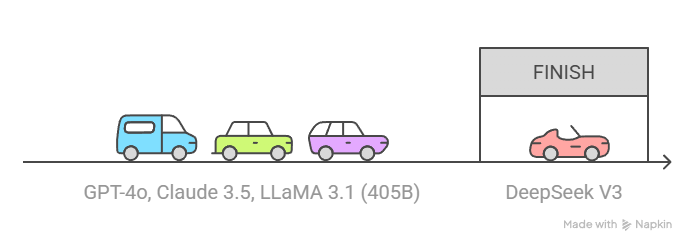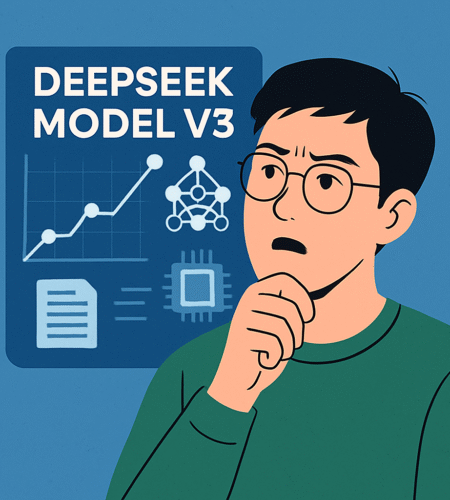Introduction: What Is DeepSeek Model V3?
DeepSeek Model V3 is a next-generation, open-source large language model (LLM) developed by DeepSeek-AI, a leading Chinese AI research lab. Released in December 2024, it leverages a Mixture-of-Experts (MoE) architecture and introduces innovations like Multi-head Latent Attention (MLA) and Multi-Token Prediction (MTP).
With 671 billion total parameters (and only 37 billion activated per token), DeepSeek V3 is a technical and economic breakthrough — combining the scale of GPT-4-class models with significantly lower inference costs and faster training.
Architecture Deep Dive: MoE + MLA + MTP
Let’s dissect the three core innovations that power DeepSeek Model V3:
1. Mixture-of-Experts (MoE)
Instead of activating the entire model for every token (as with dense LLMs), MoE activates only a small subset of “experts” — specialized sub-networks — depending on the task or input.
- Total Experts: 256
- Activated Experts per Token: 8
- Effective Params per Token: ~37B
- Result: GPT-4-level reasoning at a fraction of the GPU load.
2. Multi-head Latent Attention (MLA)
MLA introduces structured routing attention where multiple latent heads dynamically attend to tokens. This improves:
- Long-context performance (up to 128K tokens)
- Sparse expert selection accuracy
- Memory efficiency
3. Multi-Token Prediction (MTP)
Unlike traditional next-token prediction, MTP allows DeepSeek V3 to predict multiple tokens in parallel, which:
- Improves training stability
- Enables speculative decoding
- Reduces latency in real-time applications
Training Efficiency & Cost
Despite its scale, DeepSeek Model V3 was trained with extreme efficiency:
- Pretraining Data: 14.8 trillion tokens
- Training Hardware: H800 GPUs (FP8 precision)
- Total Compute: 2.788 million GPU hours
- Estimated Cost: ~$5.6M
- No irrecoverable loss spikes during training
By comparison, GPT-4 reportedly required over $50M in compute.
Performance Benchmarks
DeepSeek V3 outperforms most open-source models and rivals top closed models like GPT-4o, Claude 3.5, and Gemini 2.5 Pro.
General Language & Reasoning
| Benchmark | DeepSeek V3 | GPT-4o | Claude 3.5 | LLaMA 3.1 (405B) |
|---|---|---|---|---|
| MMLU (5-shot) | 88.5% | 87.2% | 88.3% | 88.6% |
| DROP (3-shot F1) | 91.6% | 83.7% | 88.3% | 88.7% |
| MMLU-Pro | 75.9% | 72.6% | 78.0% | 73.3% |

Math & Coding
| Benchmark | DeepSeek V3 | GPT-4o | Claude 3.5 | LLaMA 3.1 |
|---|---|---|---|---|
| HumanEval (Pass@1) | 82.6% | 80.5% | 81.7% | 77.2% |
| MATH-500 (EM) | 90.2% | 74.6% | 78.3% | 73.8% |
| AIME 2024 (Math) | 39.2% | 9.3% | 16.0% | 23.3% |
| CNMO 2024 (Chinese) | 43.2% | 10.8% | 13.1% | 6.8% |
Download DeepSeek V3: Where & How
The model is hosted on Hugging Face and is fully open-source under a MIT + Model License.
Available Variants
| Variant | Size | Use Case |
|---|---|---|
| DeepSeek-V3-Base | 671B | Research, fine-tuning |
| DeepSeek-V3 (Chat) | 671B | Chatbots, assistants, coding |
Download here: Hugging Face – DeepSeek V3
Note: The full model (Base + MTP) is ~685GB (FP8 weights)
Hardware Requirements
| Feature | Requirement |
|---|---|
| RAM (model weights) | ~685 GB |
| GPU (minimum) | 8× A100/H100 80GB for full model |
| Precision Support | FP8 (native), BF16 (via conversion) |
| Context Length | 128,000 tokens |
| Multi-GPU Support | Tensor & pipeline parallelism supported |
Don’t have 8 H100s? Consider using DeepSeek-R1-0528-Qwen3-8B or a distilled version.
DeepSeek V3 vs. DeepSeek R1: Which Should You Use?
| Feature | DeepSeek V3 | DeepSeek R1 / R1-0528 |
|---|---|---|
| Purpose | General-purpose LLM | Dedicated reasoning model |
| Output Style | Direct answers | Chain-of-thought explanations |
| Best For | Q&A, writing, summarizing | Math, logic, multi-step problems |
| RL Strategy | SFT + RLHF | Cold-start + self-correction RL |
| System Prompt Support | (V3-0324+) | (R1-0528+) |
If your workload involves reasoning, math proofs, coding, or planning agents, go with R1. For everything else — including writing or summarization — V3 is the better pick.
Running DeepSeek V3 Locally
DeepSeek V3 is compatible with multiple inference frameworks:
Supported Frameworks
| Framework | Features |
|---|---|
| SGLang | FP8, BF16, tensor/pipeline parallelism |
| vLLM | Fast inference, 128K context, AMD support |
| TensorRT-LLM | INT8/4 quantization, enterprise deployment |
| LMDeploy | Offline & online inference pipelines |
Example: Running with SGLang
git clone https://github.com/deepseek-ai/DeepSeek-V3.git
cd DeepSeek-V3/inference
pip install -r requirements.txt
python convert.py --hf-ckpt-path /models/deepseek-v3 --save-path /converted --n-experts 256 --model-parallel 16
torchrun generate.py --ckpt-path /converted --config configs/config_671B.json --interactive
Comparison: DeepSeek V3 vs LLaMA 3 vs GPT-4o
| Model | Total Params | Architecture | Training Cost | MMLU | HumanEval | License |
|---|---|---|---|---|---|---|
| DeepSeek V3 | 671B | MoE | ~$5.6M | 88.5 | 82.6% | MIT |
| LLaMA 3.1 | 405B | Dense | ~$40M+ | 88.6 | 77.2% | LLaMA License |
| GPT-4o | ? | Dense | ~$100M+ | 87.2 | 80.5% | Closed |
Bonus: Try DeepSeek-V3-0324
Released in March 2025, this version of V3 includes reinforcement learning improvements inspired by R1. It delivers:
- Better tool use and function calling
- More coherent responses
- Faster inference
For teams that need performance and speed, this is the recommended general-purpose model.
Conclusion: Why Choose DeepSeek Model V3?
If you’re looking for a high-performance, open-source LLM that can rival commercial giants in math, code, Q&A, and general tasks, DeepSeek Model V3 is the clear choice.
TL;DR:
- 671B MoE with 37B activated per token
- Top-tier benchmarks in reasoning, code, and math
- Cheaper to train & run than GPT-class models
- Self-hostable via Hugging Face, SGLang, vLLM
- Open-source (MIT) and commercially usable
Resources & Links
- DeepSeek V3 on Hugging Face
- GitHub: DeepSeek-V3 Codebase
- DeepSeek Technical Paper (arXiv)
- SGLang Setup Guide
Frequently Asked Questions about DeepSeek Model V3
1. What is DeepSeek Model V3?
DeepSeek Model V3 is a large-scale open-source language model developed by DeepSeek-AI. It uses a Mixture-of-Experts (MoE) architecture with 671 billion total parameters, activating only 37 billion per token. It’s designed for high performance in language tasks, coding, and reasoning — all while being more compute-efficient than dense models like GPT-4 or LLaMA.
2. How is DeepSeek V3 different from DeepSeek R1?
DeepSeek V3 is a general-purpose language model, while DeepSeek R1 is a reasoning-focused model optimized for math, logic, and step-by-step problem-solving. R1 builds on the V3 Base model but adds an advanced RL training pipeline for structured, explainable outputs.
3. Where can I download DeepSeek V3?
You can download DeepSeek V3 (Base and Chat variants) from Hugging Face:
https://huggingface.co/deepseek-ai
4. What is the size of the DeepSeek V3 model in GB?
The full DeepSeek V3 model (Base + Multi-Token Prediction module) is approximately 685 GB in FP8 format. If converted to BF16, expect a larger footprint.
5. What hardware is needed to run DeepSeek V3?
To run the full model:
- At least 8× NVIDIA A100 or H100 GPUs (80GB each)
- For local testing or distillation, use 1× 40–80GB GPU with smaller variants like DeepSeek-R1-0528-Qwen3-8B.
6. Is DeepSeek V3 open-source and free to use commercially?
Yes. The code is released under the MIT License, and the model weights are available under a commercial-use-friendly Model License. You can use it for research and business applications.
7. What are the key use cases for DeepSeek V3?
- Conversational agents
- Content generation
- Translation & summarization
- Code generation
- API-based Q&A systems
- LLM orchestration in agent frameworks
8. What’s the difference between DeepSeek-V3-Base and DeepSeek-V3 (Chat)?
- Base: Pretrained model for further fine-tuning or evaluation
- Chat: Instruction-tuned with RLHF, optimized for human-aligned, safe, and helpful conversation
9. How does DeepSeek V3 perform compared to GPT-4 or Claude 3.5?
DeepSeek V3 is one of the few open-source models that:
- Matches or beats GPT-4o on HumanEval and MMLU
- Outperforms Claude 3.5 on several math and code benchmarks
- Offers faster and cheaper inference due to MoE design
10. Can I run DeepSeek V3 with vLLM or SGLang?
Yes. DeepSeek V3 is compatible with:
- SGLang (supports FP8/BF16 and AMD GPUs)
- vLLM (supports large context and fast batch decoding)
- LMDeploy and TensorRT-LLM for optimized inference


Comments